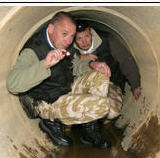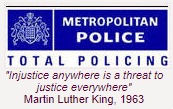HOLMES 2
Page 1 of 1 • Share
 HOLMES 2
HOLMES 2
Presently reading a ‘DI Banks’ novel and the following paragraphs set me thinking:
‘….We’ll keep an open mind. Last thing we want is to let a serial killer slip through our hands because we don’t see the connection. I take it you’ll be activating HOLMES?’
‘Yes sir’ said Winsome. The Home Office Large Major Enquiry System was an essential tool in any major investigation. Every scrap of information was entered into the computer and connections were made in ways even a trained officer might easily miss.’
I’m fairly sure we have been informed that HOLMES has been used for this case, so assuming the details from the T9 statements have all been entered correctly, why has the system not blown a gasket?
It doesn’t need a computer program to identify the nonsense that makes up these statements, so how will Grange get away without charges of gross negligence/incompetence when the day of reckoning finally comes?
Even if the answer is ‘we didn’t use HOLMES for that part of the inquiry’, just raising the question ‘why ever not’ must surely lead straight down a corruption, negligence or incompetence avenue.
.............................
This is the Wiki page on HOLMES 2:
HOLMES 2 (Home Office Large Major Enquiry System) is an information technology system that is predominantly used by UK police forces for the investigation of major incidents such as serial murders and high value frauds.
The system is a single application which was developed by Unisys for the Police Information Technology Organisation under the Private Finance Initiative. It provides total compatibility and consistency between all the Police forces of England, Scotland, Wales, and Northern Ireland, as well as the Royal Military Police. The name of the system is a reference to the fictional Arthur Conan Doyle private detective character Sherlock Holmes.
History of development
HOLMES
HOLMES was introduced in 1985 and enabled law enforcement agencies to improve effectiveness and productivity in crime investigations. Like the later HOLMES 2, it was an administrative support system which was primarily designed to assist Senior Investigation Officers in their management of the complexity of investigating serious crime. To this end, HOLMES carefully processed the mass of information it was provided with and ensured that no vital clues were overlooked.
HOLMES was also used to support the Police UK Casualty Bureau providing facilities to record reported missing persons, casualties, survivors and evacuees. The application provides matching facilities to aid the reconciliation of missing persons with those involved in the incident.
But the system had crucial weaknesses, too. It provided very little support to the investigation of the crime per se and had only very limited opportunities to link separate incidents, especially across police force boundaries. What was needed was a solution that allowed an increased amount of information exchange combined with a better use of the information.[1]
Replacement
Against this background, the British police forces started a plan to replace the existing system with a new, improved version in 1994. The new version, HOLMES 2, overcame the known weaknesses of HOLMES. Additionally, it is more flexible for future changes and provides a speedier and more efficient access to information. The system was finally released to the first forces in 2000, while the last forces became operational in early 2004.
Applications
As mentioned above, HOLMES 2's most important function is the one as a crime investigation tool. For this purpose, it is based on an organised and methodical approach, whose structure concentrates on the major incident room (MIR). This is the administrative centre where further investigation actions are coordinated and all the information from members of public, enquiry officers and other sources is gathered. With the help of input masks, HOLMES 2 is provided with the relevant information and used by the senior investigating officer to direct and control the course of the enquiry. In this respect, the system uses a combination of commercial off-the-shelf (COTS) components and purpose-built software to provide the most cost-effective system for the police service. Furthermore, the improved HOLMES embeds computer intelligence for the first time. The Dynamic Reasoning Engine (DRE), for example, makes it possible to combine the skills and experiences of crime investigators with the acquired knowledge of the system in order to identify new lines of enquiry.
Another important use of HOLMES 2 lies in disaster management. The reason for this can be seen in the similarities that exist between the investigation of a major incident and a major disaster. In case of a disaster, HOLMES 2 collaborates with the facilities for disaster management via the Casualty Bureau.[2] The additional functions required for Casualty Bureau operations, like recording Interpol data and specific action management facilities, are fully integrated into the HOLMES 2. HOLMES 2 also provides the ability to pool resources in order to handle more effectively the initial peak load of missing person calls from the public.
There is also a fully mobile version of HOLMES 2 which can be run on a laptop for use in courts or while travelling.
Technical details
The client/server architecture of HOLMES 2 is based on Microsoft Windows 2000 Professional or NT 4.0 workstations with UNIX servers running either Solaris or UnixWare. The system network communicates by using TCP/IP network protocols for LAN and WLAN communication.
Furthermore, HOLMES 2 uses a two-tier approach for local database access and a 3-tier approach for remote database access, whereby remote database access is user-configurable from the front end. A freetext database allows users to ask unstructured questions and to present the results in order of relevance. Apart from that, a dual operation was adopted to increase the speed of the system. While searches themselves were tuned at the SQL (Structured Query Language) level, additional indexes on the RDBMS (relational database management system) tables were deployed.[3]
‘….We’ll keep an open mind. Last thing we want is to let a serial killer slip through our hands because we don’t see the connection. I take it you’ll be activating HOLMES?’
‘Yes sir’ said Winsome. The Home Office Large Major Enquiry System was an essential tool in any major investigation. Every scrap of information was entered into the computer and connections were made in ways even a trained officer might easily miss.’
I’m fairly sure we have been informed that HOLMES has been used for this case, so assuming the details from the T9 statements have all been entered correctly, why has the system not blown a gasket?
It doesn’t need a computer program to identify the nonsense that makes up these statements, so how will Grange get away without charges of gross negligence/incompetence when the day of reckoning finally comes?
Even if the answer is ‘we didn’t use HOLMES for that part of the inquiry’, just raising the question ‘why ever not’ must surely lead straight down a corruption, negligence or incompetence avenue.
.............................
This is the Wiki page on HOLMES 2:
HOLMES 2 (Home Office Large Major Enquiry System) is an information technology system that is predominantly used by UK police forces for the investigation of major incidents such as serial murders and high value frauds.
The system is a single application which was developed by Unisys for the Police Information Technology Organisation under the Private Finance Initiative. It provides total compatibility and consistency between all the Police forces of England, Scotland, Wales, and Northern Ireland, as well as the Royal Military Police. The name of the system is a reference to the fictional Arthur Conan Doyle private detective character Sherlock Holmes.
History of development
HOLMES
HOLMES was introduced in 1985 and enabled law enforcement agencies to improve effectiveness and productivity in crime investigations. Like the later HOLMES 2, it was an administrative support system which was primarily designed to assist Senior Investigation Officers in their management of the complexity of investigating serious crime. To this end, HOLMES carefully processed the mass of information it was provided with and ensured that no vital clues were overlooked.
HOLMES was also used to support the Police UK Casualty Bureau providing facilities to record reported missing persons, casualties, survivors and evacuees. The application provides matching facilities to aid the reconciliation of missing persons with those involved in the incident.
But the system had crucial weaknesses, too. It provided very little support to the investigation of the crime per se and had only very limited opportunities to link separate incidents, especially across police force boundaries. What was needed was a solution that allowed an increased amount of information exchange combined with a better use of the information.[1]
Replacement
Against this background, the British police forces started a plan to replace the existing system with a new, improved version in 1994. The new version, HOLMES 2, overcame the known weaknesses of HOLMES. Additionally, it is more flexible for future changes and provides a speedier and more efficient access to information. The system was finally released to the first forces in 2000, while the last forces became operational in early 2004.
Applications
As mentioned above, HOLMES 2's most important function is the one as a crime investigation tool. For this purpose, it is based on an organised and methodical approach, whose structure concentrates on the major incident room (MIR). This is the administrative centre where further investigation actions are coordinated and all the information from members of public, enquiry officers and other sources is gathered. With the help of input masks, HOLMES 2 is provided with the relevant information and used by the senior investigating officer to direct and control the course of the enquiry. In this respect, the system uses a combination of commercial off-the-shelf (COTS) components and purpose-built software to provide the most cost-effective system for the police service. Furthermore, the improved HOLMES embeds computer intelligence for the first time. The Dynamic Reasoning Engine (DRE), for example, makes it possible to combine the skills and experiences of crime investigators with the acquired knowledge of the system in order to identify new lines of enquiry.
Another important use of HOLMES 2 lies in disaster management. The reason for this can be seen in the similarities that exist between the investigation of a major incident and a major disaster. In case of a disaster, HOLMES 2 collaborates with the facilities for disaster management via the Casualty Bureau.[2] The additional functions required for Casualty Bureau operations, like recording Interpol data and specific action management facilities, are fully integrated into the HOLMES 2. HOLMES 2 also provides the ability to pool resources in order to handle more effectively the initial peak load of missing person calls from the public.
There is also a fully mobile version of HOLMES 2 which can be run on a laptop for use in courts or while travelling.
Technical details
The client/server architecture of HOLMES 2 is based on Microsoft Windows 2000 Professional or NT 4.0 workstations with UNIX servers running either Solaris or UnixWare. The system network communicates by using TCP/IP network protocols for LAN and WLAN communication.
Furthermore, HOLMES 2 uses a two-tier approach for local database access and a 3-tier approach for remote database access, whereby remote database access is user-configurable from the front end. A freetext database allows users to ask unstructured questions and to present the results in order of relevance. Apart from that, a dual operation was adopted to increase the speed of the system. While searches themselves were tuned at the SQL (Structured Query Language) level, additional indexes on the RDBMS (relational database management system) tables were deployed.[3]

Doug D- Posts : 3719
Activity : 5286
Likes received : 1299
Join date : 2013-12-03
 Similar topics
Similar topics» Further Analysis of the Last Photo
» 'MINI' Sherlock Holmes!
» Let us always bear in mind - Sherlock Holmes probably got it right.
» 'MINI' Sherlock Holmes!
» Let us always bear in mind - Sherlock Holmes probably got it right.
Page 1 of 1
Permissions in this forum:
You cannot reply to topics in this forum





































